Hello community,
Sharing my project should somebody find this useful. I could not find any info here on using any custom batteries with stock Bosch motors (apart few posts stating that Bosch motors only work with stock batteries and it's not worth the hassle in general). However I was able to find some posts on German forums and armed with Google Translate I was able to understand that it's possible to trick the system by connecting extra battery in parallel to the stock battery.
I wanted to have a EU-legal e-bike without spending two extra grand on spare batteries, since my requirements are 100+ km horizontal, 2+ km vertical distance while towing a child trailer.
Hard requirements:
- Don't ruin the bike
- Don't ruin the warranty
I picked Canyon Pathlite:ON 7 as a vehicle with a good price/value ratio and started experimenting. It also had a power socked that allows charging the bike without removing the battery. My crazy idea was to use this socket to access the power line of the battery, thus not making any irreversible changes to the bike.
I also had two 48 V 16 Ah batteries as leftovers from my previous projects, so preferably I'd like to reuse them and not buy anything else. Obviously this ruled out parallel connection since the bike runs on 36 volts, so the voltage converter was necessary. Fortunately a decent converter is an order of magnitude cheaper than two batteries, so that was the way.
Step 1: Figure out whether power connector can be used to access the power line.
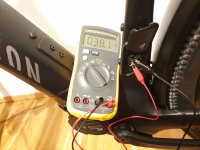
Looks good!
Less temporary solution:
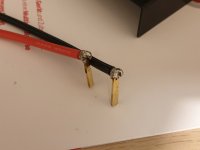
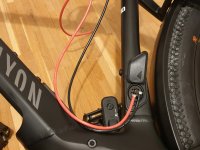

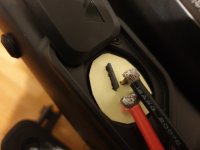
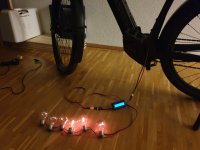
Great success!
A bunch of lightbulbs drawing power from the bike's stock battery!
Thermal glue to the rescue to turn all this shit and sticks into a makeshift plug:
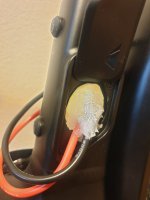
I bought a 800W DC-DC Converter from Aliexpress (the bike's motor is 250W, so 800 "chinese" watts should be enough, right) for 40 bucks.
The converted (surprisingly!) turned out to be an adjustable CC/CV power supply (i.e. a proper lithium battery charger!), so I thought the following:
- Set the output voltage to 37 V (mid of the "36V" battery voltage range);
- Set the output current to maximum possible.
That way,
- the stock battery would always stay at 50%;
- the converter and the "extender" battery would kick in as soon as the voltage of the main battery drops due to load from the motor;
- the converter would provide maximum current to keep the voltage of the stock battery intact, effectively rerouting *all* load from the stock battery to the "extender" battery.
That way,
- the stock battery would stay effectively unused as long as "extender" battery provides power to the converter;
- the bike would first drain the "extender" battery to zero; having two of them I would easily swap out the emptied one and replace with a fresh one on the go;
- I would never have to recharge the stock battery, or even remove it from the bike;
- the stock battery would always stay at the most comfortable charge level;
- due to no effective usage, the stock battery lifespan would be only limited by aging, and not the cycles (=> live much longer);
- I would still have the "safety buffer" by the (lower half of) the stock battery when I drain both extender batteries during a trip.
Here's the intended layout I had in mind:
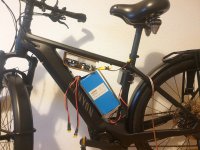
To be continued. In the next post: Not everything went as planned. Bosch is still shit.
Sharing my project should somebody find this useful. I could not find any info here on using any custom batteries with stock Bosch motors (apart few posts stating that Bosch motors only work with stock batteries and it's not worth the hassle in general). However I was able to find some posts on German forums and armed with Google Translate I was able to understand that it's possible to trick the system by connecting extra battery in parallel to the stock battery.
I wanted to have a EU-legal e-bike without spending two extra grand on spare batteries, since my requirements are 100+ km horizontal, 2+ km vertical distance while towing a child trailer.
Hard requirements:
- Don't ruin the bike
- Don't ruin the warranty
I picked Canyon Pathlite:ON 7 as a vehicle with a good price/value ratio and started experimenting. It also had a power socked that allows charging the bike without removing the battery. My crazy idea was to use this socket to access the power line of the battery, thus not making any irreversible changes to the bike.
I also had two 48 V 16 Ah batteries as leftovers from my previous projects, so preferably I'd like to reuse them and not buy anything else. Obviously this ruled out parallel connection since the bike runs on 36 volts, so the voltage converter was necessary. Fortunately a decent converter is an order of magnitude cheaper than two batteries, so that was the way.
Step 1: Figure out whether power connector can be used to access the power line.

Looks good!
Less temporary solution:





Great success!
A bunch of lightbulbs drawing power from the bike's stock battery!
Thermal glue to the rescue to turn all this shit and sticks into a makeshift plug:

I bought a 800W DC-DC Converter from Aliexpress (the bike's motor is 250W, so 800 "chinese" watts should be enough, right) for 40 bucks.
The converted (surprisingly!) turned out to be an adjustable CC/CV power supply (i.e. a proper lithium battery charger!), so I thought the following:
- Set the output voltage to 37 V (mid of the "36V" battery voltage range);
- Set the output current to maximum possible.
That way,
- the stock battery would always stay at 50%;
- the converter and the "extender" battery would kick in as soon as the voltage of the main battery drops due to load from the motor;
- the converter would provide maximum current to keep the voltage of the stock battery intact, effectively rerouting *all* load from the stock battery to the "extender" battery.
That way,
- the stock battery would stay effectively unused as long as "extender" battery provides power to the converter;
- the bike would first drain the "extender" battery to zero; having two of them I would easily swap out the emptied one and replace with a fresh one on the go;
- I would never have to recharge the stock battery, or even remove it from the bike;
- the stock battery would always stay at the most comfortable charge level;
- due to no effective usage, the stock battery lifespan would be only limited by aging, and not the cycles (=> live much longer);
- I would still have the "safety buffer" by the (lower half of) the stock battery when I drain both extender batteries during a trip.
Here's the intended layout I had in mind:

To be continued. In the next post: Not everything went as planned. Bosch is still shit.




